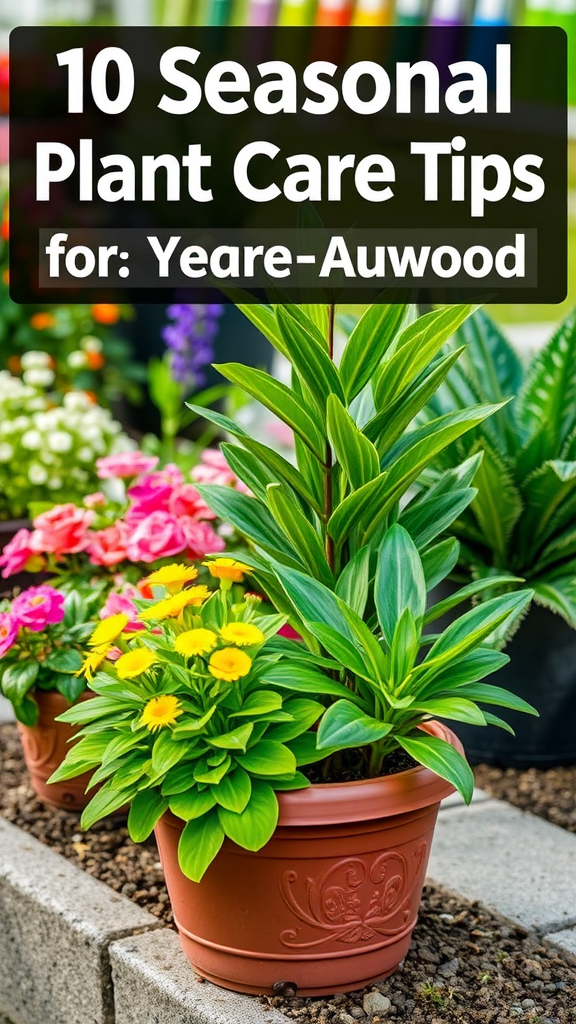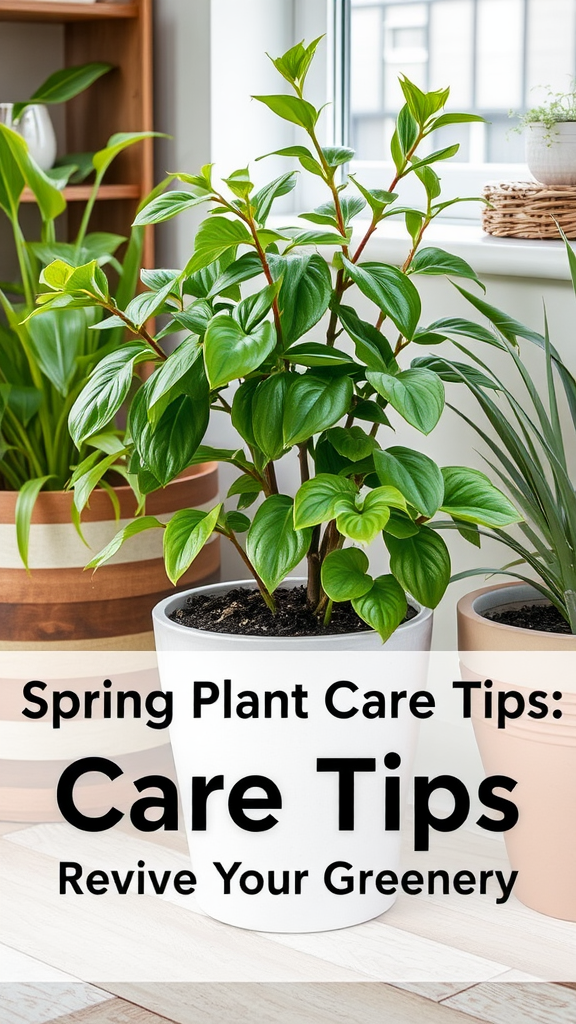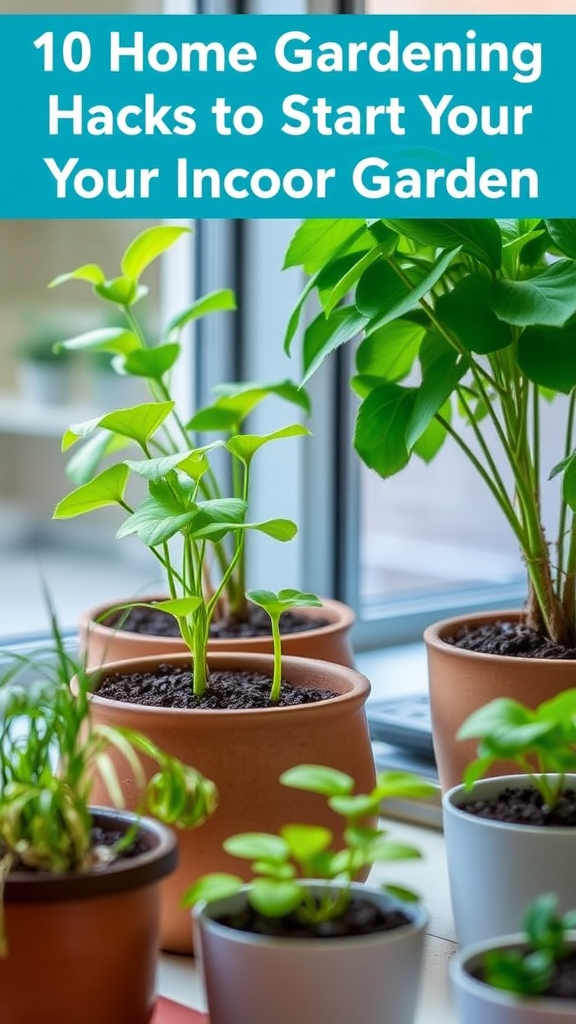10 Seasonal Plant Care Tips for Year-Round Success
Taking care of your plants requires a keen understanding of their needs throughout the seasons. Ensuring your plants thrive year-round calls for specific, seasonal care strategies. Here are some essential tips to get you started on nurturing your green friends effectively.
1. Understand Seasonal Changes
Each season brings unique challenges and opportunities for plant care. During spring, plants awaken from dormancy, while summer’s heat demands more water and shade. In fall, it’s time for preparation, and winter requires protection from harsh conditions. Being aware of these seasonal shifts is crucial to providing the right care.
2. Adjust Watering Schedule
Plants need varied amounts of water depending on the season. In spring and summer, increase watering frequencies as temperatures rise. However, in fall and winter, many plants enter dormancy and require much less water. Always check the soil moisture before watering, as overwatering can be just as harmful as underwatering.
3. Fertilize Wisely
Feeding your plants is essential for growth, but when you do it matters. During the growing season (spring and summer), use a balanced fertilizer to promote strong development. As fall approaches, reduce feeding to help your plants prepare for dormancy. Avoid fertilizing during the winter months to prevent stimulating growth that can’t be supported by the conditions.
4. Prune Regularly
Regular pruning keeps plants healthy and encourages new growth. Spring is a great time to prune flowering plants after they bloom, removing dead or damaged branches. Summer pruning can help manage growth and shape your plants. In the fall, cut back perennials as they die back, and get rid of any diseased foliage to protect your garden from pests.
5. Monitor Temperature and Humidity
Indoor plants, in particular, thrive at specific temperature and humidity levels. During winter, you might want to introduce a humidifier to keep your plants from drying out due to indoor heating. Conversely, ensure good air circulation in the summer to prevent overheating and mildew. Be attentive to your plants’ signs of distress.
6. Rotate Your Plants
Plants tend to lean toward the light source, so rotating them regularly can help them grow evenly. A simple twist every week allows all sides of your plants to receive equal sunlight exposure, preventing a lopsided appearance and ensuring balanced growth.
7. Prepare for Pests and Diseases
Seasonal changes can bring about different pests and diseases. Keep an eye on your plants, especially in spring when new growth appears. Early detection is key! Apply horticultural oil or insecticidal soap to manage pests. In the fall, clear away fallen leaves or debris where pests might hide.
8. Protect During Frost
As the temperature drops in late fall and winter, certain plants may need protection from frost. Use row covers, blankets, or even old sheets to shield delicate plants from nighttime chill. For outdoor gardens, consider mulching to insulate roots and prevent frost from penetrating the soil.
9. Repot When Necessary
Spring is often a great time to repot your houseplants as they start their growing season. Check for root-bound plants and consider moving them to larger containers. Fresh potting mix provides nutrients and encourages healthy growth. Be sure to do this during warmer months to minimize stress on the plant.
10. Embrace Seasonal Plants
Change up your garden with seasonal plants for vibrant colors and variety. In spring, try tulips and daffodils; summer is perfect for sunflowers and zinnias. Autumn brings cozy hues with asters and chrysanthemums, and winter can shine with evergreens. This not only makes your garden visually appealing but encourages biodiversity.
By following these tips, you can ensure that your plants remain healthy and vibrant throughout the changing seasons. Give your plants the attention they need, and you’ll enjoy a lush, thriving garden all year long!
Common Mistakes in Seasonal Plant Care and How to Avoid Them
Maintaining a vibrant garden year-round can be a fulfilling yet challenging task. One of the best ways to ensure that your plants thrive is to avoid common pitfalls in seasonal plant care. Understanding these mistakes can help you nurture your garden more effectively and enhance its overall beauty.
Overwatering Plants
One prevalent mistake among gardeners is overwatering. It’s easy to assume that giving plants plenty of water is beneficial, but this can lead to root rot and other problems. To avoid this, always check the soil moisture before watering. Stick your finger into the soil; if it feels dry an inch below the surface, it’s time to water.
Not Adjusting Fertilizer Amounts
Each season brings different nutrient needs for your plants. In spring, when plants are growing actively, they typically need more nitrogen. However, in winter, their growth slows, requiring significantly less fertilization. Follow these tips:
- Use a balanced fertilizer in the spring and summer.
- Reduce fertilizing frequency in fall and winter.
- Opt for slow-release fertilizers to provide steady nutrients.
Ignoring Pest Prevention
Pests can wreak havoc on your plants, especially during warmer months. While it’s tempting to wait until you see an infestation, preventing pests is crucial. Regularly inspect your plants for signs of trouble and take action early. Implement these strategies:
- Introduce beneficial insects like ladybugs that prey on harmful pests.
- Use organic pesticides as a first line of defense.
- Rotate crops each season to disrupt pest life cycles.
Planting at the Wrong Time
Timing is essential for successful gardening. Many gardeners mistakenly plant too early in the spring or too late in the fall. Familiarize yourself with your area’s frost dates and seasonal temperature patterns. Following these guidelines can help ensure healthy plant growth:
- Start seeds indoors about 6-8 weeks before the last frost date.
- Transplant seedlings outside once temperatures are consistently warm.
- Consider fall planting for certain varieties that thrive in cooler weather.
Neglecting Soil Health
The foundation of your garden’s success lies in healthy soil. Some gardeners overlook soil quality or fail to amend it seasonally. Test your soil regularly to check pH levels and nutrient content. To enhance soil health, keep in mind:
- Add organic compost to boost nutrient content.
- Use mulch to retain moisture and suppress weeds.
- Rotate your crops to maintain soil fertility and health.
Choosing the Wrong Plants
Picking plants that aren’t suited for your specific climate or soil conditions is a common mistake. Before planting, research which species thrive best in your area. Consider these points:
- Check USDA hardiness zones to find suitable plants for your region.
- Opt for native plants that are more resilient to local pests and diseases.
- Be mindful of sunlight levels in your garden when selecting plant varieties.
Failure to Prune
Pruning is essential for healthy plant growth but is often forgotten. Many gardeners fail to remove dead or damaged branches, leading to potential disease in the plant. Regular pruning encourages new growth and enhances the plant’s overall structure. To effectively prune your plants:
- Remove any dead or infected branches immediately.
- Prune during the dormant season for most trees and shrubs.
- Always use clean, sharp tools to prevent transmission of diseases.
Not Preparing for Winter
As the cold months approach, neglecting winterization can lead to serious plant damage. It’s essential to prepare your garden for the harsh winter conditions. Make these practices part of your seasonal plant care:
- Mulch around the base of plants to protect roots from freezing.
- Bring sensitive plants indoors or provide adequate shelter.
- Water thoroughly before the ground freezes to help plants cope with winter stress.
By being mindful of these common mistakes, you can enhance your seasonal plant care efforts. Implementing these strategies will not only support the health of your plants but also make gardening a more enjoyable experience year-round. Remember, a little preparation goes a long way in nurturing a thriving garden.
Conclusion
Embracing the rhythm of the seasons can significantly enhance your gardening experience and foster thriving plants year-round. By following the ten seasonal plant care tips outlined in this article, you can create an environment where your green companions flourish, regardless of the time of year. Always remember to adjust your plant care routines to the specific needs of each season, ensuring proper watering, fertilization, and light conditions.
It’s equally important to stay aware of common mistakes that can derail your efforts. Overwatering, neglecting to repot, and ignoring pest issues are pitfalls that many gardeners face. By learning to recognize these potential challenges and implementing practical solutions—like proper drainage, timely repotting, and regular inspections—you can maintain a healthy garden ecosystem.
You have the tools and knowledge to cultivate a thriving garden sustainably. Commit to a proactive approach and keep your plants healthy and vibrant. Engage with your plants, monitor their progress, and adjust your care as needed. This not only leads to beautiful flora but also enhances your connection to nature.
With these insights in mind, you are well-equipped to create a flourishing garden, enjoying the rewards of your hard work and dedication throughout every season. Remember, gardening is a continual learning process, and with patience and love, you can achieve year-round success for your beloved plants.





